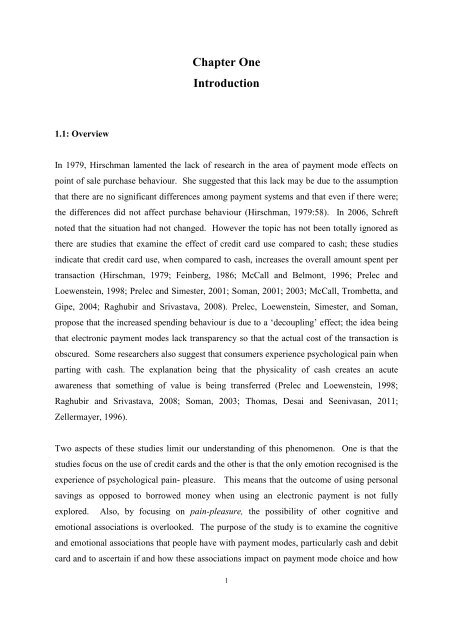Cash or Card: Consumer Perceptions of Payment Modes - Scholarly ...
Cash or Card: Consumer Perceptions of Payment Modes - Scholarly ...
Cash or Card: Consumer Perceptions of Payment Modes - Scholarly ...
You also want an ePaper? Increase the reach of your titles
YUMPU automatically turns print PDFs into web optimized ePapers that Google loves.
1.1: Overview<br />
Chapter One<br />
Introduction<br />
In 1979, Hirschman lamented the lack <strong>of</strong> research in the area <strong>of</strong> payment mode effects on<br />
point <strong>of</strong> sale purchase behaviour. She suggested that this lack may be due to the assumption<br />
that there are no significant differences among payment systems and that even if there were;<br />
the differences did not affect purchase behaviour (Hirschman, 1979:58). In 2006, Schreft<br />
noted that the situation had not changed. However the topic has not been totally ign<strong>or</strong>ed as<br />
there are studies that examine the effect <strong>of</strong> credit card use compared to cash; these studies<br />
indicate that credit card use, when compared to cash, increases the overall amount spent per<br />
transaction (Hirschman, 1979; Feinberg, 1986; McCall and Belmont, 1996; Prelec and<br />
Loewenstein, 1998; Prelec and Simester, 2001; Soman, 2001; 2003; McCall, Trombetta, and<br />
Gipe, 2004; Raghubir and Srivastava, 2008). Prelec, Loewenstein, Simester, and Soman,<br />
propose that the increased spending behaviour is due to a ‘decoupling’ effect; the idea being<br />
that electronic payment modes lack transparency so that the actual cost <strong>of</strong> the transaction is<br />
obscured. Some researchers also suggest that consumers experience psychological pain when<br />
parting with cash. The explanation being that the physicality <strong>of</strong> cash creates an acute<br />
awareness that something <strong>of</strong> value is being transferred (Prelec and Loewenstein, 1998;<br />
Raghubir and Srivastava, 2008; Soman, 2003; Thomas, Desai and Seenivasan, 2011;<br />
Zellermayer, 1996).<br />
Two aspects <strong>of</strong> these studies limit our understanding <strong>of</strong> this phenomenon. One is that the<br />
studies focus on the use <strong>of</strong> credit cards and the other is that the only emotion recognised is the<br />
experience <strong>of</strong> psychological pain- pleasure. This means that the outcome <strong>of</strong> using personal<br />
savings as opposed to b<strong>or</strong>rowed money when using an electronic payment is not fully<br />
expl<strong>or</strong>ed. Also, by focusing on pain-pleasure, the possibility <strong>of</strong> other cognitive and<br />
emotional associations is overlooked. The purpose <strong>of</strong> the study is to examine the cognitive<br />
and emotional associations that people have with payment modes, particularly cash and debit<br />
card and to ascertain if and how these associations impact on payment mode choice and how<br />
1

















